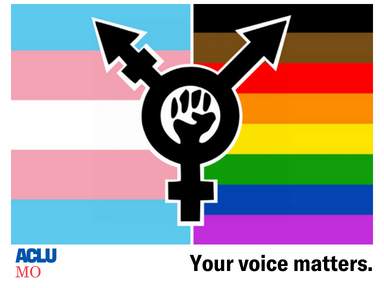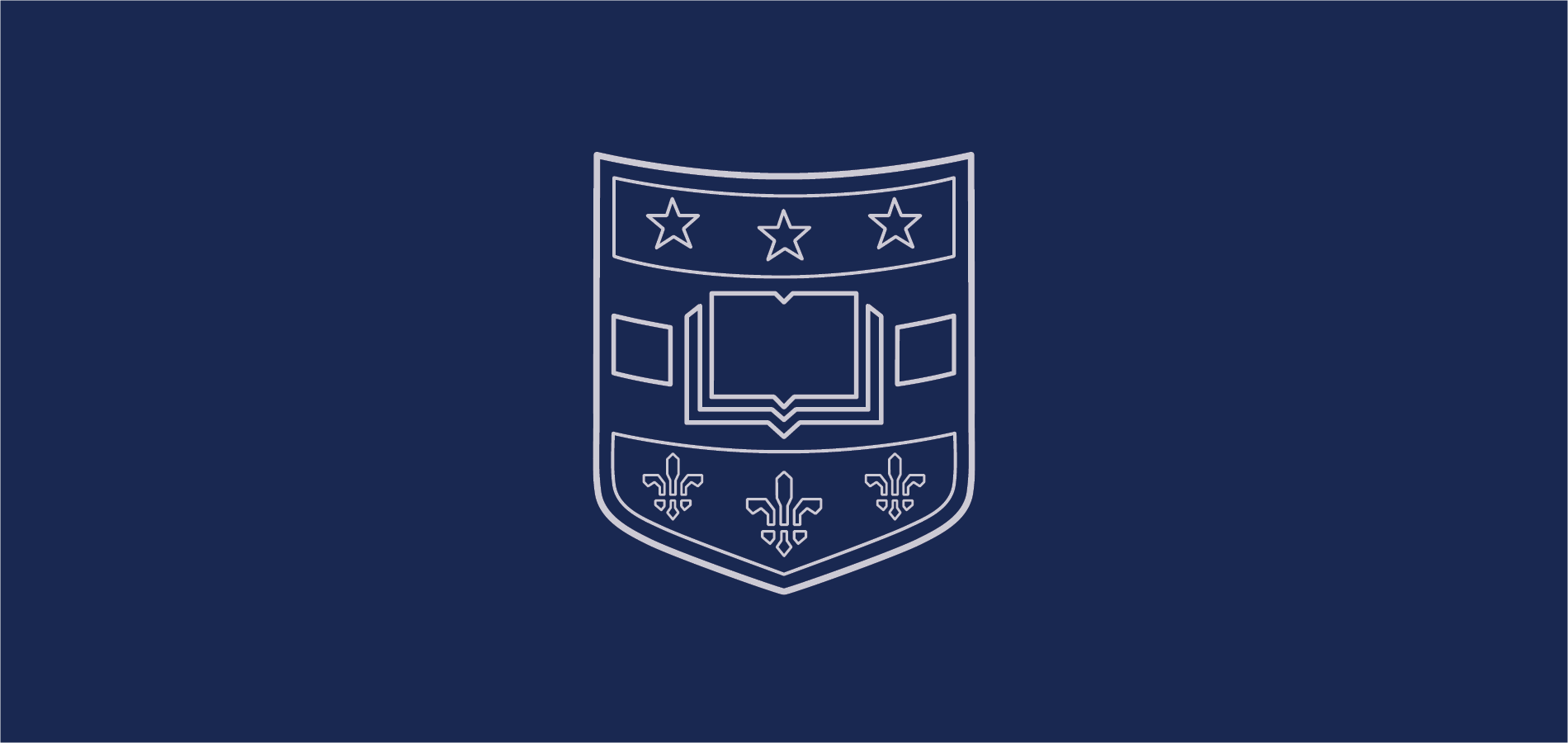
ACLU-MO History Spotlight: LGBTQ+ Equity
LGBTQ+ Equity
In 1972, the ACLU of Eastern Missouri’s new executive director, Joyce Armstrong, prioritized building relationships with local gay and lesbian groups. She spoke to the Mandrake Society, St. Louis’ first gay rights or “homophile” organization, and coordinated with leaders at the gay- and lesbian-focused Metropolitan Community Church (MCC).
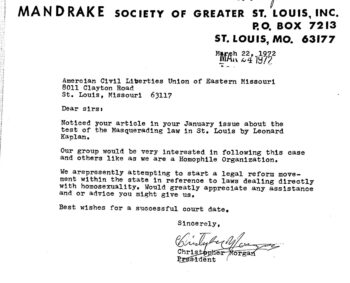
Soon, the ACLU of Eastern Missouri (as it was then called) began researching specific instances of discrimination against gay, lesbian, bisexual, trans, and queer people in community. Two of the largest cases were ending laws against cross-dressing in St. Louis city, and ensuring gay students could have the opportunity to organize at the University of Missouri-Columbia.
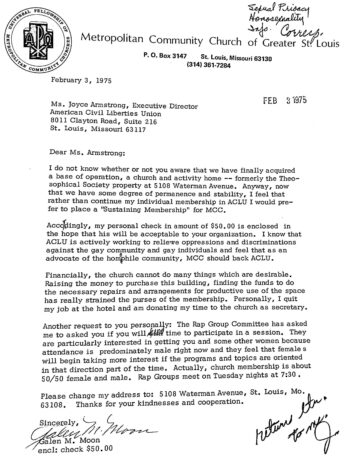
Cross-Dressing Ordinance
Since 1843, St. Louis city law classified someone appearing “in a dress not belonging to their sex” as a misdemeanor. By the 20th century, police routinely used this “masquerading” law to harass gender-nonconforming people.
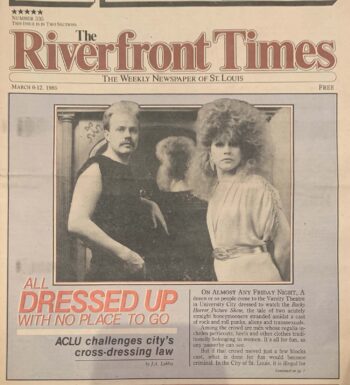
Actions, 1972–1986
The ACLU took Goldstein Johnson’s case to the Missouri Supreme Court. Johnson, a young African American, was arrested several times for wearing wigs, shoes with heels, “a long suede bag and a three quarter length fur coat.” Tragically, the case was dismissed when Johnson was shot dead outside a bar in 1972.
A second case was built in the 1980s, when the ACLU helped three more individuals file suit: Michael Shreves, charged for drag performances at Uncle Marvin’s bar, and two others who remained anonymous (“D.D.” and “D.C.”), arrested wearing women’s clothing in public, although their official IDs stated male.
The ACLU showed that the law was not enforced regularly or evenly. Performances such as Torch Song Trilogy at the Muny or a concert by Prince at the Arena clearly violated this law, but faced no charges. Popular events like the annual Central West End Halloween party included many men wearing dresses—the St. Louis mayor was even pictured in the newspaper posing with several men dressed as The Supremes. Instead, the law was used by police to harass the behavior and actions of people who did not conform to expected gender norms while in public.
The “masquerading” law was finally ruled unconstitutional in 1986.
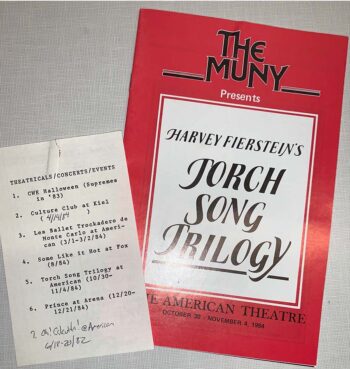
From ACLU-MO Records (wua00355), series 3, box 9
‘Gay Lib’ Student Group
In 1971, students at the University of Missouri-Columbia formed a club to discuss gay and lesbian life. They asked for recognition as an official campus group. After three years of rejection by the university, the students sought help from the ACLU of Eastern Missouri.
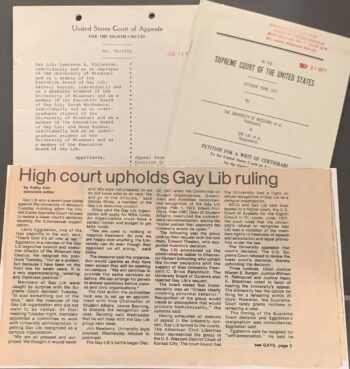
Court documents and “High Court Upholds Gay Lib Ruling” Columbia, Missouri, newspaper article.
From ACLU-MO Records (wua00355) series 3, box 18
Actions, 1974–1979
On March 29, 1974, Gay Lib v. University of Missouri was filed in US District Court. In 1977, the 8th Circuit Court of Appeals ruled for the students, stating “it was a violation of the members’ rights to freedom of speech and association and equal protection under the law.” The Supreme Court declined the university’s request for further appeal.
Contemporary Efforts
The ACLU of Missouri continues to “ensure that lesbian, gay, bisexual, and transgender people can live openly without discrimination and enjoy equal rights, personal autonomy, and freedom of expression and association.” A key court case, Barrier v. Vasterling, was won in October 2014, ensuring that same-sex marriages from other states would be recognized in Missouri. In 2018, the ACLU Transgender Education and Advocacy Program was launched in Missouri.
More
- Andris, James. Columbia, Mo. Pride Celebration. (Aug. 4, 2011)
- “Beyond Gender Binaries” Mapping LGBTQ St. Louis, 1945 -1992. (2017)
- Leonard, Arthur S. Sexuality and the Law: An Encyclopedia of Major Legal Cases. (Garland Pub., 1993):145-150.
- Gay Lib v. University of Missouri, 558 F. 2d 848 8th Cir. (1977).
- D.C. and M.S. v. City of St. Louis, 795 F. 2d 652 8th Cir. (1986).
ACLU-MO @ 100
This post is part of a series in recognition of the American Civil Liberties Union of Missouri’s centennial year (1920-2020).
If you have a question about this post or other topics related to St. Louis history, I can be reached at mrectenwald@wustl.edu or on Twitter: @mrectenwald.

